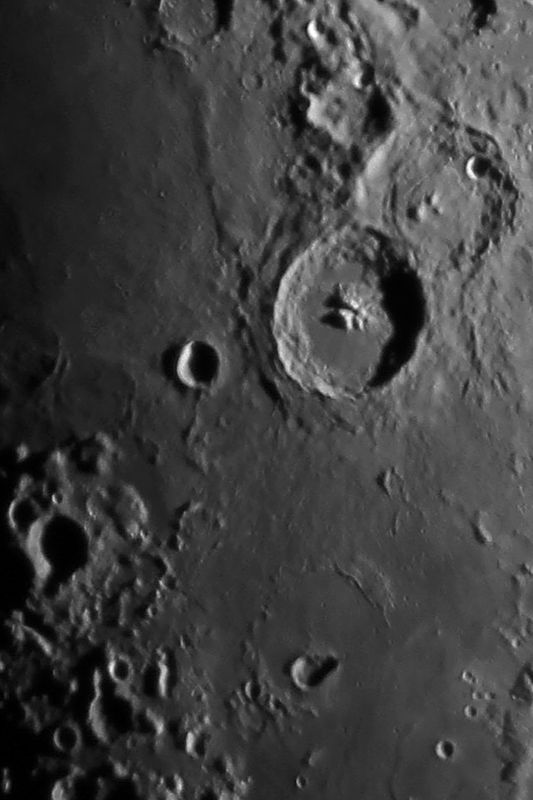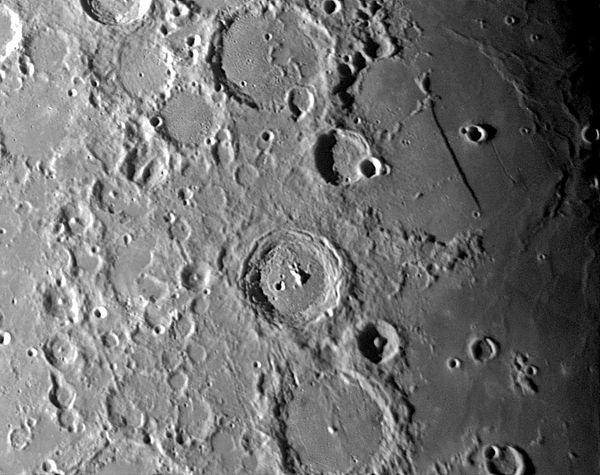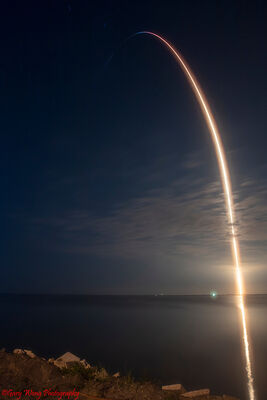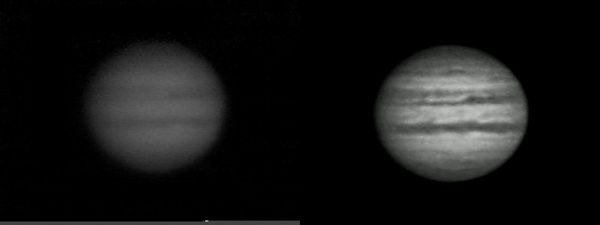High resolution moon shots
Dec 9, 2014 22:22:03 #
Here are two of my better images of the moon. Both were taken through a 14-inch telescope at f/90 and the images were stacks of 75 exposures each 1/15 second taken during exceptional seeing conditions. The first is an image of the large crater Theophilus with the pear shaped crater Torricelli near the bottom. Theophilus is approximately 68 miles in diameter and Torricelli is about 13 miles across.
The second photo is the vicinity of the Straight Wall, the long straight shadow at upper right. The small crack in the ground coming from the shadow of the crater Birt is about 3/4 mile wide. Tiny craterlets to as small as 1/2 mile can be found along the smooth areas of the moon. At the very bottom of image two is a large crater Alphonsus with a small mountain in it's center. From the mountain at roughly the 7 o'clock position and near the crater wall is where the Ranger 9 spacecraft impacted with the moon in 1965.
The second photo is the vicinity of the Straight Wall, the long straight shadow at upper right. The small crack in the ground coming from the shadow of the crater Birt is about 3/4 mile wide. Tiny craterlets to as small as 1/2 mile can be found along the smooth areas of the moon. At the very bottom of image two is a large crater Alphonsus with a small mountain in it's center. From the mountain at roughly the 7 o'clock position and near the crater wall is where the Ranger 9 spacecraft impacted with the moon in 1965.
Dec 9, 2014 23:37:45 #
Dec 10, 2014 06:25:07 #
Dec 10, 2014 08:56:57 #
dlmorris
Loc: Loma Linda, Ca
Nice! I especially like the one with the strength wall. Very clear image?
Dec 10, 2014 11:34:10 #
Dec 10, 2014 17:59:34 #
I always look forward to you posts, Algol. Thank you for such great suff.
Dec 27, 2014 06:33:07 #
Curious why you stacked images....and chose to take 15 second subs. I assume you were using a DSLR.
Lastly, I am just up the road, Spartanburg SC - we have an awesome Astronomy club, Roper Mountain Astronomy. You will have to join us.
Lastly, I am just up the road, Spartanburg SC - we have an awesome Astronomy club, Roper Mountain Astronomy. You will have to join us.
Dec 27, 2014 19:01:13 #
nikonshooter wrote:
First I appreciate you looking at my images and the offer to join you at Roper Mountain Astronomy.Curious why you stacked images....and chose to take 15 second subs. I assume you were using a DSLR.
Lastly, I am just up the road, Spartanburg SC - we have an awesome Astronomy club, Roper Mountain Astronomy. You will have to join us.
Lastly, I am just up the road, Spartanburg SC - we have an awesome Astronomy club, Roper Mountain Astronomy. You will have to join us.
Yes, I am using a DSLR. As for stacking the images, it clears up the images greatly and reduces the noise/graininess inherent in a single long exposure shot, especially at the high ISO's I typically use. I will post a couple of images to illustrate the fact at a later date.
As for the 15 second exposures, I am assuming you are referring to my long exposures posted elsewhere and not the 1/15 second exposures of the moon posted above. I usually test different exposure times to determine how long I can go and to see how well the telescope mount is tracking before the star images become elongated. Most times (without auto guiding in effect) a 15 second exposure on the 6-inch and larger instruments is about all I can do. Rarely can I get 30 second exposures. I use a portable mount and this varies with each time I set it up. If I had a permanent observatory this of course would be much longer as I could tweak the mount to a much greater precision. I hope this answers your question.
Dec 28, 2014 00:10:25 #
Algol wrote:
I totally understand trapping photons on DSO's but not too sure why you are doing this with the moon. I can routinely, shoot at F/5.6 or F.7, ISO 100, 1/250 of a second using a Nikon D810 and a F/4 200x400 lens. There no noise, no drift, and one shot is all I need. If I put this camera on my 8 inch SCT, F/10 I may bump the ISO up to 200 ...and 1/200 of a second and the exposure is spot on. First I appreciate you looking at my images and th... (show quote)
Where in Ga are you from?? we use to have a farm outside of Athens.
Dec 28, 2014 13:07:48 #
Algol wrote:
Thank you Jerry, it certainly answers the questions I didn't ask yet. I too drag my 4.5" & 8" out of the garage every time I want to use them.First I appreciate you looking at my images and th... (show quote)
Great shots Jerry I always like your work.
Dec 28, 2014 13:13:12 #
nikonshooter wrote:
I really would like to see some of your work posted here at the Astronomical Photography Forum.I totally understand trapping photons on DSO's but not too sure why you are doing this with the moon. I can routinely, shoot at F/5.6 or F.7, ISO 100, 1/250 of a second using a Nikon D810 and a F/4 200x400 lens. There no noise, no drift, and one shot is all I need. If I put this camera on my 8 inch SCT, F/10 I may bump the ISO up to 200 ...and 1/200 of a second and the exposure is spot on.
Where in Ga are you from??.....we use to have a farm outside of Athens.
Where in Ga are you from??.....we use to have a farm outside of Athens.
Dec 29, 2014 14:48:11 #
nikonshooter wrote:
I live in a small town just 30 miles west of Atlanta called Winston, GA. It's on I-20 but I live about 3 miles south of I-20. I still get that horrendous glow from Atlanta.I totally understand trapping photons on DSO's but not too sure why you are doing this with the moon. I can routinely, shoot at F/5.6 or F.7, ISO 100, 1/250 of a second using a Nikon D810 and a F/4 200x400 lens. There no noise, no drift, and one shot is all I need. If I put this camera on my 8 inch SCT, F/10 I may bump the ISO up to 200 ...and 1/200 of a second and the exposure is spot on.
Where in Ga are you from??.....we use to have a farm outside of Athens.
Where in Ga are you from??.....we use to have a farm outside of Athens.
The following sample of Jupiter illustrates the advantage of stacking multiple images to produce a single high quality image. In this case a Lynx CCD camera (7.5mmx5.7mm chip) on a 16-inch telescope operating at f/45 yielding an effective focal length of 18,288mm. This produced a field of view that was 84 seconds of arc on the long axis. Jupiter at the time was approximately 40 seconds of arc in diameter. The moon in comparison is 30 minutes or 1,800 seconds of arc in diameter. These extreme focal lengths insure that Jupiter presents the maximum size and appropriate exposure to obtain the final image. A total of 400 images were shot at a rate of 100 images per second for a duration of 4 seconds. Jupiter rotates in 10 hours (the earth in respect rotates in 24 hours), so one has to be careful and keep the total exposure time short or smearing of the surface details will occur at high focal lengths.
The image on the left is a single exposure and shows just how grainy the image is. The image on the right is a stack of all 400 images and it reveals a wealth of detail not seen on the single image.
I hope this helps in explaining the reason behind stacking. I used the ccd images because they show a more dramatic sense of stacking, but the same holds true with DSLR images when used at very high focal ratios.
If you want to reply, then register here. Registration is free and your account is created instantly, so you can post right away.







